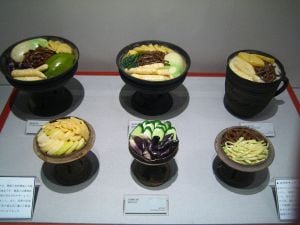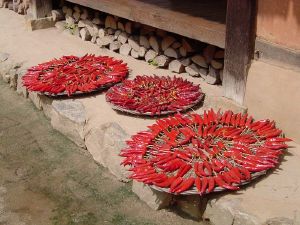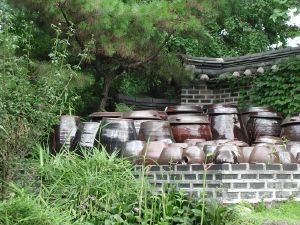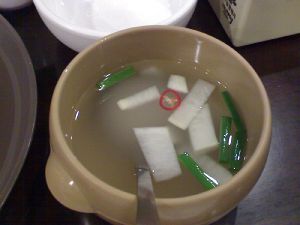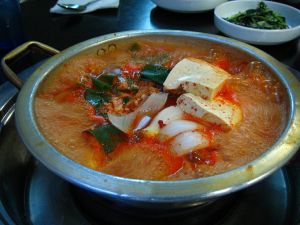Kimchi
| Kimchi | ||||||||
|---|---|---|---|---|---|---|---|---|
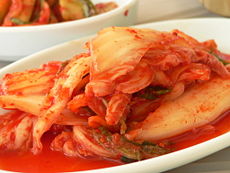 | ||||||||
| Korean name | ||||||||
|
Kimchi, also spelled gimchi or kimchee, is a traditional Korean fermented dish made of seasoned vegetables.
Kimchi is the most common Korean banchan eaten with rice along with other banchan dishes. Kimchi is also a common ingredient and cooked with other ingredients to make dishes such as kimchi stew (kimchi jjigae) and kimchi fried rice (kimchi bokkeumbap). Kimchi is also popular in Japan.[1]
History
The history of kimchi traces back to ancient times. References to kimchi can be found as early as 2600-3000 years ago.[2] The first text-written evidence of its existence can be found in the first Chinese poetry book, ShiKyung. In this book, kimchi was referred as “Ji”, the term used before it was known as “Chimchae”.[3]
The earliest form of kimchi consisted of only salted vegetables and It was in the 12th century when people began to include other spices to create different flavors, such as sweet and sour savor, and colors of kimchi, such as white and orange.[4]
Chili peppers, now a standard ingredient in kimchi, were unknown in Korea until the early 17th century. Chili peppers originated from the New World and were introduced to East Asia by western traders.[5] This particular style of kimchi made with chili peppers and baechu, a variety of Chinese cabbage, gained popularily in the 19th century and this baechu kimchi continues to be the most common and popular form of kimchi today.[6]
Composition
Kimchi's composition can be separated into the main vegetable ingredient and the mix of seasonings used to flavor the kimchi. While the most popular type of kimchi is the napa cabbage variety, countless different types exist, including regional and seasonal varieties. Popular variants include kkakdugi (깍두기) which is a kimchi made with cubed radishes, and oh-ee so-bae-gi (오이소배기) which is a stuffed cucumber kimchi. Kkaennip (깻잎) kimchi features layers of perilla leaves marinated in soy sauce and other spices. The Kimchi Field Museum in Seoul has documented 187 historic and current varieties of kimchi. Although the most common seasonings include brine, garlic, scallions and chili pepper grind, countless varieties of seasoning and ingredients can be replaced or added depending on the type of kimchi being made. Common seasonings also include ginger, onions, salted fish or shellfish as well as fruit or fresh seafood.
Moreover, kimchi is not necessarily spicy or red. White kimchi (baekkimchi) is seasoned without the chili pepper grind and is neither red in color nor spicy. White radish kimchi (dongchimi) is another example of a popular kimchi that is not spicy. A popular dish of cold noodles in "donchimi" brine (dongchimi gooksu) is eaten widely during the summer months.
Kimchi varieties
Kimchi can be categorized by main ingredients, regions or seasons. Korea's northern and southern sections have a considerable temperature difference.[7] Northern regions tend to have longer winters compared to the southern regions of Korea. Kimchi from the northern parts of Korea tend to have less salt as well as less red peppers and usually do not have brined seafood for seasoning. Northern kimchi often has a watery consistency. Unlike northern styles, kimchi in the southern parts of Korea, such as Jeolla-do and Gyeongsang-do, uses salt, chili peppers and salted fish liberally. Depending upon the season of the year, the various weather conditions, and ingredients available in the region, different varieties of kimchi are produced.
By main ingredients
By regions
(The entire section's reference)[7]
- Hamgyeongdo (Upper Northeast)
Due to its proximity to the ocean, people in this particular region use fresh fish and oysters to season their kimchi.
- Hwanghae-do (MidWest)
The taste of kimchi in Hwanghaedo can be best described as "moderate" — not bland but not overly spicy. Most kimchi from this region has less color since red pepper flakes are not used. The typical kimchi for Hwanghaedo is called pumpkin kimchi (bundi).
- Gyeonggi-do (Lower Midwest of Hwanghaedo)
People use a wide variety of vegetables and seasonings to make kimchi. Gyeonggido kimchi is also well known for its eye-catching decorations.
- Chungcheong-do (Between Gyeonggido and Jeollado)
Instead of using fermented fish, people in the region rely on salt and fermentation to make savory kimchi. Chungcheongdo is known for the greatest varieties of kimchi.
- Gangwon-do (MidEast)
Compared to other regions, it is very typical in Gangwondo to store kimchi for longer periods of time. Unlike other coastal regions in Korea, kimchi in this area does not contain much salted fish.
- Jeolla-do (Lower Southwest)
People use different types of fermented fish, such as salted yellow corvine and salted butterfish to create different seasonings for kimchi.
- Gyeongsang-do (Lower Southeast)
This region is famous for salty and spicy flavors in its dishes and their kimchi is no exception. The most common seasoning components are salted anchovies and salt, which produce a briny and savory flavor.
By season
(The entire section's reference)[8]
- Spring
Traditionally, after a long period of consuming kimjang kimchi (winter kimchi) during the winter, fresh potherbs and vegetables were popular for making kimchi. These kinds of kimchi were not fermented or even stored for long periods of time but were freshly consumed.
- Summer
Young summer radishes and cucumbers are popular summer vegetables made into kimchi, yeolmu kimchi, in summer are made with whole summer radishes that are eaten in several bites. Brined fish or shellfish can be added and freshly ground dried chili peppers are often used.
- Autumn
Baechu kimchi is the most common type of kimchi in the fall. It is prepared by inserting blended stuffing materials, called sok(literally meaning inside), between layers of salted leaves of uncut, whole cabbage. The ingredients of sok can vary, depending on the different regions and weather conditions. Generally, beachukimchi tends to have a strong salty flavor because it contains a large amount of fermented fish or shellfish.
- Winter
Traditionally, the greatest varieties of kimchi were available during the winter. In preparation for the long winter months, many types of kimchi were prepared in early winter and stored in the ground in large kimchi pots. These days, kimchi refrigerators offering precise temperature controls are used to store winter kimchi. It is often November or December when people begin to make kimchi and women often gather together in each others' homes to help with winter kimchi preparations. White kimchi (baek kimchi), is a common and popular kimchi to make during the wintertime. "Baechu" is made with salted cabbage filled with thin strips of radish, parsley, pine nuts, pears, chestnuts, shredded red pepper, manna lichen (석이버섯), garlic, and ginger.
Health effects
Kimchi is made of various vegetables and contains a high concentration of dietary fibers, while being low in calories. It also provides 80% of the daily required amount of ascorbic acid and carotene.[9] Most types of kimchi contain common ingredients like onions, garlic and peppers all of which have well-known health benefits. The vegetables being made into kimchi also contribute to the overall nutritional value. Kimchi is rich in vitamin A, thiamine (B1), riboflavin (B2), calcium and iron,[10][11] and also has active and beneficial bacterial cultures of Lactobacilli,[12] which results in a higher lactic acid content in the final product than in yoghurt.
Kimchi has a reputation of being a healthy food. It has been recommended by popular health magazines, such as the periodical Health, which named kimchi in its list of top five "World's Healthiest Foods" for being rich in vitamins, aiding digestion, and even possibly retarding cancer growth. [13] However, research has also found kimchi to be a risk factor in gastric cancer (most likely due to nitrates and salt) while nonfermented alliums and nonfermented seafood were found to be protective factors. [14] Interestingly, research has also found kimchi to be both a protective factor against and also a risk factor for gastric cancer[15].
Kimichi in popular culture
- Most Koreans store kimchi in a separate refrigerator that is designed to keep kimchi at an optimal temperature for proper fermentation.[16]
- The South Korean Korea Aerospace Research Institute (KARI) are hoping to have the first Korean in space to experiment with kimchi while aboard the Russian-manned space ship Soyuz. KARI has developed a space-safe kimchi recipe by sterilizing the food with radiation blasts, heat, freezing and packaging.[17]
- When taking photographs, South Koreans often say the word "kimchi" the same way English speakers would use the word "cheese".[18]
See also
- Korean cuisine
- List of Korea-related topics
- List of English words of Korean origin
- Sauerkraut
- Fermentation (food)
ReferencesISBN links support NWE through referral fees
- ↑ http://www.american.edu/TED/kimchi.htm
- ↑ Kimchi Expo 2003 (Chinese)
- ↑ Hankyorei21 (Korean)
- ↑ Kimchi Museum Official Website
- ↑ =46 고추. Encyclopedia of Korean national culture. Retrieved 2006-12-09.
- ↑ Tour2Korea
- ↑ 7.0 7.1 "Kimchi." Yahoo Korean Encyclopedia
- ↑ "Kimchi in Korea: By Season." Korea Agro-Fisheries Trade Corp. (Korean)
- ↑ Bae, Christina. "Kimchi?Korean Fermented Food." University of Bristol.
- ↑ Food in Korea. Asianinfo.com. Retrieved 2007-01-30.
- ↑ Kimchi. Tour2korea.com. Retrieved 2007-01-30.
- ↑ Goddik, Lisbeth Meunier, et al. "Handbook of Food and Beverage Fermentation Technology.", New York: Marcel Dekker, Inc, 2004.
- ↑ Raymond, Joan "World's Healthiest Foods: Kimchi (Korea)" Health Magazine. <http://www.health.com/health/article/0,23414,1149143,00.html>
- ↑ Nan et al., Kimchi and soybean pastes are risk factors of gastric cancer <http://www.wjgnet.com/1007-9327/11/3175.pdf>
- ↑ Kim et al., Dietary factors and stomach cancer: a case-control study in Korea. International Journal of Epidemiology 1995; 24: 33-41
- ↑ http://www.tdctrade.com/imn/02031402/food19.htm
- ↑ http://www.wired.com/news/technology/0,71607-0.html
- ↑ http://www.asianinfo.org/asianinfo/korea/food.htm
External links
- Korean traditional kimchi
- Korea National Tourism Organization's Kimchi page
- Kimchi Field Museum, Seoul
- Korea Food Research Institute
 PDF
PDF
Credits
New World Encyclopedia writers and editors rewrote and completed the Wikipedia article in accordance with New World Encyclopedia standards. This article abides by terms of the Creative Commons CC-by-sa 3.0 License (CC-by-sa), which may be used and disseminated with proper attribution. Credit is due under the terms of this license that can reference both the New World Encyclopedia contributors and the selfless volunteer contributors of the Wikimedia Foundation. To cite this article click here for a list of acceptable citing formats.The history of earlier contributions by wikipedians is accessible to researchers here:
The history of this article since it was imported to New World Encyclopedia:
Note: Some restrictions may apply to use of individual images which are separately licensed.
